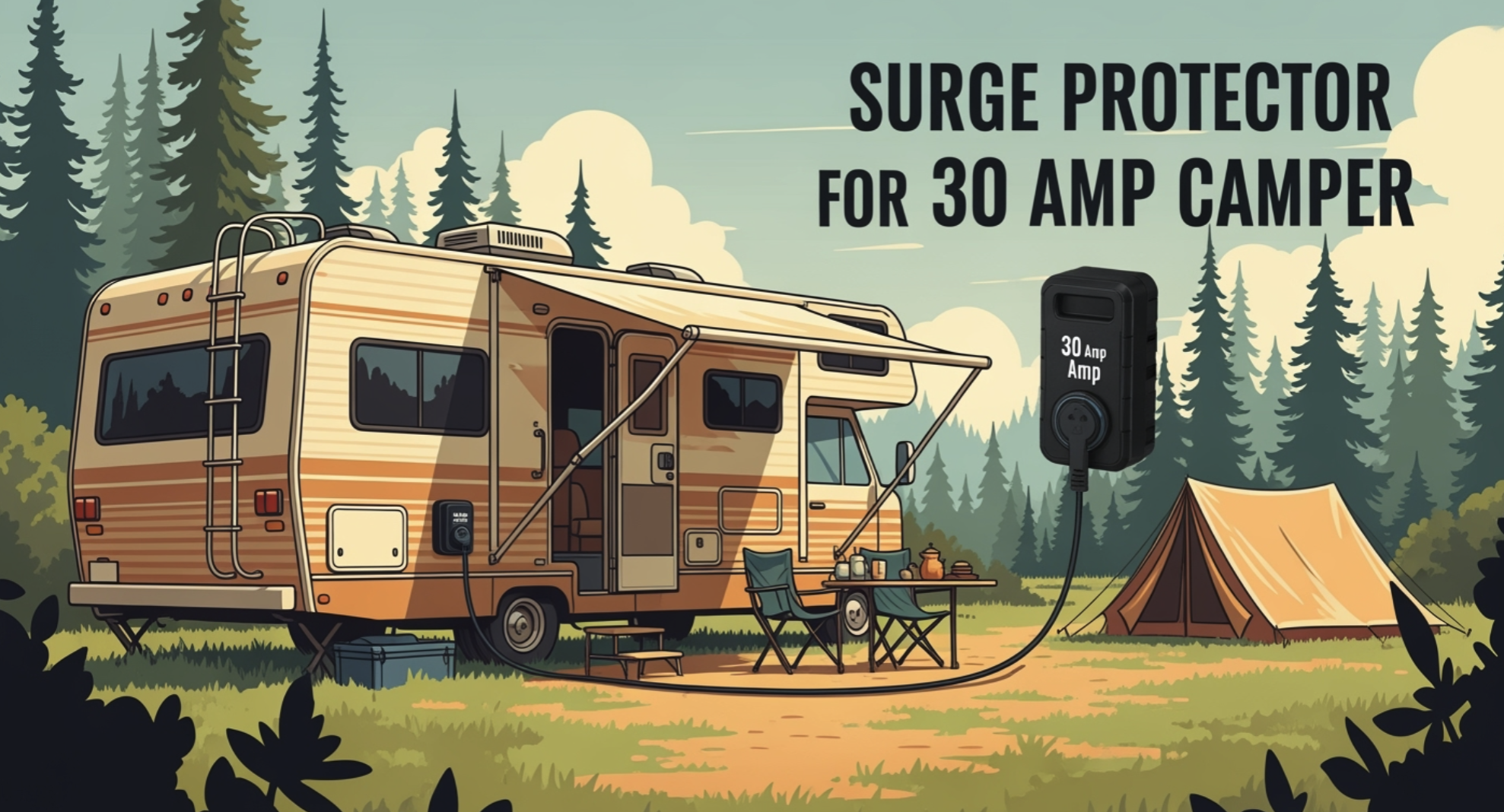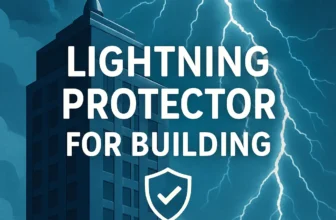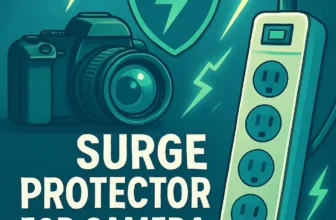Published By: Sean Hudson | Last updated on September 18, 2025 and reviewed by Editorial Team

Imagine pulling into a campground, excited to relax, only to find your 30-amp camper’s electrical system fried by a sudden power surge. Such a nightmare scenario is more common than you think. A surge protector for a camper acts as your first line of defense, shielding your appliances and electronics from unpredictable voltage spikes. Without it, you risk costly repairs and potential safety hazards. Protecting your camper’s electrical system isn’t just smart—it’s essential for worry-free adventures.
Why You Need a Surge Protector for 30 Amp Camper
Understanding Power Surges
Causes of power surges in campgrounds
Campgrounds often have unpredictable electrical environments. Power surges can occur for several reasons, and understanding these causes helps you understand why protection is crucial. One common cause is the use of unstable power sources. Campground pedestals may experience low voltage when multiple campers plug in high-demand devices. This strain on the system can lead to sudden voltage spikes. Another frequent issue is mis-wiring, where accidental connections result in dangerous voltage levels, such as 240V instead of the standard 120V.
Weather-related events, like lightning strikes, also contribute to power surges. A single strike can send a massive surge through the electrical grid, damaging your camper’s system. Faulty wiring in older campgrounds adds to the risk, creating open ground or neutral conditions that compromise safety.
Without a surge protector for your 30-amp RV, these scenarios could leave your appliances and electronics vulnerable to irreparable damage.
Impact of power surges on camper electrical systems
Power surges don’t just harm your devices—they can wreak havoc on the electrical system as a whole. Sensitive appliances, such as air conditioners and refrigerators, are particularly at risk. Voltage fluctuations can cause these devices to malfunction or even fail.
Rapid on-and-off power supply, another common issue, can shorten the lifespan of your equipment.
Surges can also damage your camper’s wiring and circuits. Overheating wires from voltage spikes can lead to electrical fires, posing a significant risk to your safety. Repairing these damages often comes with a hefty price tag, making prevention a more prudent choice.
A surge protector acts as a shield, absorbing excess voltage and ensuring your camper’s electrical system remains intact.
Common Electrical Risks in Campgrounds
Unstable power sources and voltage fluctuations
Campgrounds are notorious for unstable power sources. Voltage fluctuations are a common issue, particularly during peak usage periods. When multiple campers use high-demand appliances, the voltage can drop significantly. This low voltage can overheat wires, increasing the risk of fires.
On the other hand, sudden voltage spikes can damage your devices, resulting in poor performance or complete failure.
Another risk arises from open or floating ground conditions resulting from faulty wiring. These issues can create dangerous situations, including electrical shocks. Without a surge protector, you expose yourself and your camper to these hazards. A reliable 30-amp surge protector for your camper ensures that voltage remains stable, protecting your equipment and keeping you safe.
Risks from lightning strikes and faulty wiring
Lightning strikes are a major concern for campers. A single strike can send a surge through the campground’s electrical system, damaging everything connected to it. Even if your camper isn’t directly hit, the resulting surge can still cause significant harm.
Faulty wiring in older campgrounds adds another layer of risk. Issues like open ground, open neutral, and corroded connections can lead to short circuits and blown fuses.
These risks aren’t just about inconvenience—they can lead to serious safety hazards. Electrical fires, appliance failures, and even personal injury are all possibilities. Investing in an RV surge protector minimizes these risks, giving you peace of mind during your camping trips.
Benefits of Using a Surge Protector for Campers
Protecting Your Camper’s Electrical System
Safeguarding sensitive appliances and electronics
Your camper is more than just a vehicle; it’s your home on wheels. Inside, you rely on sensitive appliances like air conditioners, refrigerators, and microwaves to make your trips comfortable. A surge protector for camper 30 amp acts as a shield, protecting these devices from sudden voltage spikes. Without it, a single power surge could damage or destroy your appliances, leaving you with costly replacements.
Surge protectors regulate and divert excessive voltage, ensuring your electronics stay safe and functional.
Extending the lifespan of your camper’s electrical components
Electrical components in your camper, such as wiring and circuit boards, are not designed to handle frequent power fluctuations. Over time, these fluctuations can weaken your system, leading to premature failures. A surge protector absorbs and blocks power surges, preserving the integrity of your camper’s electrical system.
This simple device can significantly extend the lifespan of your components, saving you from the need for frequent repairs and replacements.
Avoiding Expensive Repairs
Examples of repair costs for electrical damage
Electrical damage in campers can be shockingly expensive. For instance, replacing a fried air conditioning unit can cost anywhere from $1,000 to $2,000. Repairing damaged wiring or circuits can often add an additional $500 to $1,000 to your bill. These costs don’t even account for the inconvenience of being without power during your trip.
A camper surge protector prevents these scenarios, sparing you from hefty repair expenses.
How surge protectors save money over time
Investing in a surge protector is a smart financial decision. While the upfront cost of a high-quality surge protector might range from $100 to $300, it pays for itself by preventing costly repairs. Think of it as insurance for your camper’s electrical system. By absorbing voltage spikes and stabilizing power, a surge protector ensures your appliances and wiring remain intact, saving you money in the long run.
Ensuring Safety for Your Family
Reducing the risk of electrical fires
Electrical fires are a serious hazard in campers, often caused by overheating wires or faulty connections. A surge protector minimizes this risk by detecting and addressing electrical faults before they escalate. It acts as a safety net, ensuring that voltage remains within safe limits and preventing dangerous situations.
Preventing harm from faulty power connections
Campground power pedestals can be unpredictable. Loose connections, miswiring, or open grounds can create unsafe conditions. These issues not only damage your camper but also pose a risk to your family’s safety. A surge protector for camper 30 amp defends against these threats, giving you peace of mind.
With features like voltage monitoring and auto shutoff, it ensures your camper stays safe, no matter where you park.
Risks of Not Using a Camper Surge Protector
Damage to Electrical Systems
Fried circuits and damaged wiring
Skipping a surge protector exposes your camper’s electrical system to severe damage. Power surges can damage circuits, leaving your wiring vulnerable and potentially unsafe. The circuit board, one of the most sensitive components, often takes the brunt of the damage. Even partial damage can lead to intermittent functionality, making your appliances unreliable.
Over time, these issues escalate, requiring costly repairs or replacements. Without protection, your camper’s wiring may overheat during voltage spikes, increasing the risk of electrical fires.
A single surge could turn your dream camping trip into a financial nightmare.
Loss of expensive appliances and electronics
Power surges don’t just harm your wiring—they can destroy your appliances too. Sensitive devices, such as refrigerators, air conditioners, and desktop power supplies, are particularly vulnerable. For instance, the compressor in your fridge might withstand smaller surges, but a larger one could render it useless. Replacing these appliances can cost hundreds or even thousands of dollars.
Worse, intermittent damage might go unnoticed until it’s too late, leaving you stranded without essential equipment. A surge protector acts as a barrier, ensuring your electronics remain safe and functional.
Safety Concerns
Increased risk of electrical fires
Electrical fires are a hidden danger when surge protection is skipped. Voltage fluctuations beyond a 10% tolerance can cause wires to overheat, creating a fire hazard. Faulty campground wiring or overloaded circuits amplify this risk.
For example, plugging a high-amperage device into a lower-amperage supply can trip breakers—or worse, cause them to fail.
Lightning strikes add another layer of danger, sending massive surges through the system. A surge protector helps mitigate these risks by stabilizing voltage and preventing overheating, keeping your camper and family safe.
Potential harm to occupants from power issues
Electrical problems don’t just damage your camper—they can harm you and your loved ones—power issues like open grounds or miswiring increase the risk of electrical shock. A rapid on-and-off power supply can also damage devices like air conditioners, which need a delay before restarting.
In extreme cases, weather events such as lightning strikes can result in personal injury through fire or electrical shock.
Without a surge protector, you’re leaving your family vulnerable to these dangers. Protecting your camper’s electrical system is about more than convenience—it’s about ensuring everyone’s safety.
Note: Always inspect campground power pedestals before plugging in. A surge protector with diagnostic tools can help identify potential hazards, giving you peace of mind.
How to Choose the Right Surge Protector for Your RV
Key Features to Look For
Durability, weather resistance, and portability
When selecting a surge protector, durability should be your top priority. Campgrounds expose your equipment to harsh conditions like rain, dust, and extreme temperatures. A weather-resistant surge protector ensures reliable performance, even in challenging environments.
Look for models with robust casings that can withstand wear and tear from frequent use.
Portability is another critical factor. Compact and lightweight designs make it easier to carry and store your surge protector while traveling.
Built-in diagnostic tools and LED indicators
Diagnostic tools and LED indicators are essential for monitoring your power connection. These features provide real-time feedback, helping you identify potential issues before they cause damage.
For example, indicator lights can confirm whether your devices are protected or if there’s a problem with the power source.
Always choose a surge protector with UL 1449 certification, which guarantees compliance with safety standards.
Additionally, check the joule rating to match your needs.
For small electronics, 1,000 joules suffice, while larger appliances require 2,000 joules or more.
Advanced Functionalities
Voltage monitoring and auto shutoff features
Advanced functionalities, such as voltage monitoring, enhance the performance of your surge protector. These features maintain a stable voltage supply, ensuring your devices operate at peak performance. Voltage regulation prevents damage from fluctuations, which can shorten the lifespan of sensitive electronics.
Auto shutoff features add an extra layer of protection by disconnecting power when unsafe conditions arise. This functionality is handy in campgrounds with unstable power sources.
EMS (Electrical Management Systems) for comprehensive protection
For the ultimate safeguard, consider a surge protector with an Electrical Management System (EMS). EMS-equipped models offer comprehensive protection by detecting and addressing a wide range of electrical issues, including low voltage, high voltage, and power surges. They also provide multi-stage protection, utilizing advanced components to effectively suppress surges.
Investing in an EMS-enabled surge protector ensures that your camper’s electrical system remains safe and functional, regardless of where you park.
Warranty and Customer Support
Importance of a reliable warranty
A reliable warranty reflects the manufacturer’s confidence in their product. Look for surge protectors with warranties that cover at least one to three years. This coverage protects your investment and provides peace of mind.
In the event of defects or failures, a good warranty ensures that you won’t have to bear the replacement costs. High-quality surge protectors often come with extended warranties, making them a worthwhile investment.
Checking for responsive customer service
Responsive customer service is just as important as the product itself. Before purchasing, research the manufacturer’s reputation for support. Quick and helpful responses to inquiries or issues can save you time and frustration. Companies that prioritize customer satisfaction often provide detailed user manuals, troubleshooting guides, and accessible support channels.
Choosing a surge protector from a brand with excellent customer service ensures you’ll have assistance when you need it most.
Tip: Compare features, warranties, and customer reviews before making your final decision. A little research can go a long way in finding the perfect surge protector for camper 30 amp.
How to Use a Surge Protector for Your Camper
Setting Up Your Surge Protector
Plugging into the power pedestal correctly
Setting up your surge protector is straightforward but requires careful attention to ensure safety. Follow these steps to connect it properly:
-
Turn off the breakers at the campground’s power pedestal. This step prevents any sudden power surges while you set up.
-
Plug your surge protector directly into the power pedestal. Ensure it fits securely to avoid loose connections.
-
Turn the breakers back on after the surge protector confirms a safe connection. Most models will display a green light or similar indicator.
-
Plug your camper’s power cord into the surge protector. Double-check that the connection is tight and stable.
-
Attach the cord to your camper’s electrical inlet. Once everything is connected, your system is ready to use.
This process ensures your camper’s electrical system is protected from the moment you connect to the campground’s power supply. Skipping any step could expose your camper to unnecessary risks.
Checking diagnostic lights before connecting your camper
Before fully connecting your camper, always inspect the diagnostic lights on your surge protector. These lights provide critical information about the power pedestal’s condition. For example, a green light typically indicates a safe connection, while red or blinking lights may signal issues like open grounds, reversed polarity, or low voltage.
If the lights indicate a problem, avoid plugging in your camper until the issue is resolved. This simple check can save you from potential electrical damage or safety hazards.
Tip: Keep your surge protector’s user manual handy. It explains what each diagnostic light means, helping you quickly identify and address any issues.
Maintenance Tips
Regularly inspecting for wear and tear
Routine inspections are crucial to ensure your surge protector operates effectively. Look for visible signs of damage, such as cracks, frayed wires, or corrosion on the connectors. These issues can compromise the device’s performance and safety. Periodically test the diagnostic lights to ensure they’re working correctly.
If you notice any irregularities, consider replacing the surge protector to maintain optimal protection.
Storing your surge protector safely when not in use
Proper storage extends the lifespan of your surge protector. When not in use, store it in a dry, cool place, away from direct sunlight and extreme temperatures. Use a protective case or bag to shield it from dust and moisture.
Avoid leaving it connected to the power pedestal when your camper is unplugged, as this can expose it to unnecessary wear or environmental damage.
A surge protector for a camper is more than just a device—it’s your safeguard against costly repairs and safety risks. Choosing the right one doesn’t have to break the bank. Match its amperage to your camper’s system and evaluate features like portability and protection levels.
Such a small investment protects your appliances, wiring, and peace of mind. Whether you’re upgrading your RV or planning a trip, a surge protector keeps your camper safe and running smoothly. Secure your adventures today for worry-free camping for years to come.
FAQ
What is the primary purpose of a 30-amp surge protector?
A 30-amp surge protector shields your camper’s electrical system from voltage spikes and power surges. It prevents damage to appliances, wiring, and circuits, ensuring your camper stays safe and functional during your trips.
Can a surge protector prevent damage from lightning strikes?
Yes, a surge protector can absorb excess voltage caused by lightning strikes. While it won’t stop the strike itself, it minimizes the impact on your camper’s electrical system, protecting appliances and wiring from severe damage.
Do I need a surge protector if the campground seems reliable?
Yes, even reliable campgrounds can experience voltage fluctuations or miswiring. A surge protector acts as insurance, protecting your camper from unexpected electrical issues that could arise at any time.
Are all 30-amp surge protectors weather-resistant?
Not all models are weather-resistant. Look for surge protectors with durable, weatherproof casings to ensure they perform well in rain, dust, or extreme temperatures. This feature is crucial for outdoor camping environments.
Can I use a 30-amp surge protector with a 50-amp camper?
No, a 30-amp surge protector is designed for 30-amp systems. Using it with a 50-amp camper could lead to inadequate protection. Always match the surge protector’s amperage to your camper’s electrical system.
What happens if I don’t use a surge protector?
Without a surge protector, your camper is vulnerable to power surges, voltage fluctuations, and miswiring. These issues can damage appliances, fry circuits, and even cause electrical fires, leading to costly repairs and safety risks.








